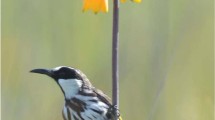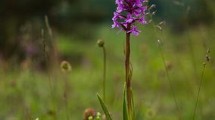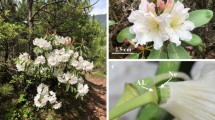Abstract
To understand the adaptive nature of floral nectar production it is necessary to determine for individual plants the associated costs and benefits in terms of growth and/or reproduction1-3. Nectar production may use up to 37% of a plant's available energy4,5 but might not affect growth or reproduction. I report here that removal of nectar from flowers of Christmas bells (Blandfordia nobilis) increased the plant's net nectar production but reduced its ability to produce seeds. To our knowledge this is the first demonstration that nectar production entails a cost to a plant in terms of growth and/or reproduction and that both the gains and costs associated with nectar production may be estimated in the same 'currency' (seeds). As a plant's nectar production increases, there should therefore be a trade-off between pollinator-mediated increases in numbers of fertilized seeds1-3 and decreases in seed number due to the costs of producing the nectar.
Similar content being viewed by others
References
Pyke, G. H. Theor. Populat. Biol. 20, 326–343 (1981).
Pyke, G. H. in Foraging Behavior. Ecological, Ethological, and Psychological Approaches (eds Kamil, A. C. & Sargent, T. D.) ( Garland, New York, 1981).
Pyke, G. H. & Waser, N. M. Biotropica 13, 260–270 (1981).
Pleasant, J. M. & Chaplin, S. J. Oecologia 59, 232–238 (1983).
Southwick, E. E. Ecology 65, 1775–1779 (1984).
Pyke, G. H., Day, L. P. & Wale, K. A. Aust. J. Ecol. 13, 279–284 (1988).
Zimmerman, M. & Pyke, G. H. Aust. J. Ecol. 13, 93–99 (1988).
Zimmerman, M. & Pyke, G. H. Aust. J. Ecol. 13, 301–309 (1988).
Corbet, S. A. & Delfosse, E. S. Aust. J. Ecol. 9, 125–139 (1984).
Gill, F. B. Biotropica 20, 169–171 (1988).
Pleasants, J. M. Am. J. Bot. 70, 1468–1475 (1983).
Zimmerman, M. & Pyke, G. H. J. Ecol. 76, 777–789 (1988).
Zimmerman, M. Oikos 41, 57–63 (1983).
Zimmerman, M. Am. Midl. Nat. 120, 50–57 (1988).
Author information
Authors and Affiliations
Rights and permissions
About this article
Cite this article
Pyke, G. What does it cost a plant to produce floral nectar?. Nature 350, 58–59 (1991). https://doi.org/10.1038/350058a0
Received:
Accepted:
Issue Date:
DOI: https://doi.org/10.1038/350058a0
- Springer Nature Limited
This article is cited by
-
Floral nectar reabsorption and a sugar concentration gradient in two long-spurred Habenaria species (Orchidaceae)
BMC Plant Biology (2023)
-
Flower choice by the stingless bee Tetragonula carbonaria is not influenced by colour-similarity to a higher-reward flower in the same patch
Apidologie (2023)
-
Temporal variation of floral reward can improve the pollination success of a rare flowering plant
Arthropod-Plant Interactions (2023)
-
Nectar secretion patterns are associated to nectar accessibility in a guild of crepuscular-nocturnal flowering plants
Plant Ecology (2022)
-
Pollinator divergence and pollination isolation between hybrids with different floral color and morphology in two sympatric Penstemon species
Scientific Reports (2020)





